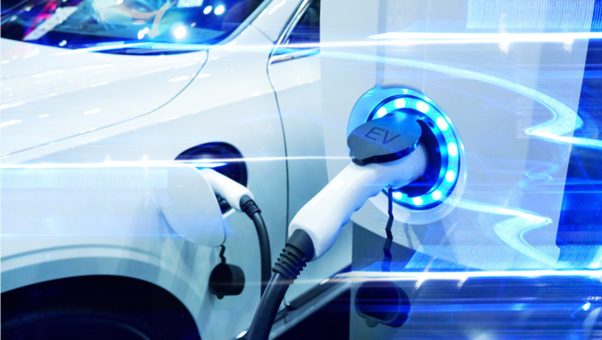Clark Dai - Meet an Expert from the Electric Vehicle Industry


Introduction
With rapid advancements in automotive technology, the pursuit of solutions that enhance performance, reliability, and efficiency for electric vehicles (EVs) is constant.
Innovative technology, introduced to the market by MacDermid Alpha Electronics Solutions, not only offers enhanced performance for EVs, but also contributes to the creation of more sustainable and eco-friendly automotive systems. Examples of this are low-temperature solder and silver sintering that can play a role in carbon emission reduction.
Clark Dai, one of MacDermid Alpha’s EV Technology market managers, explores market technologies and the automotive sector, while highlighting the role our products play in supporting the critical needs of the industry. He delves into its applications, benefits, and the transformative impact, propelling OEMs into a new era of technological excellence.

There are 3 main types of power module used in certain EV markets today, Si-IGBT (Silicon insulated-gate bipolar transistor), Si-Mosfet (Silicon Metal Oxide Silicon Field Effect Transistors) and SiC-Mosfet (Silicon Carbide Metal Oxide Silicon Field Effect
CLARK: The Si-lGBT is the main application in this market as the voltage ranges from the 200-volt EV platform to the 800-volt. It can match the EV requirements because it’s a long-term, well-established technology. There is no wafer shortage or issues in this market. There is good long-term assurance for the devices and no problems for manufacturing yields. For the other modules it is a different story. The use of SiC-Mosfet technology is quickly increasing in the EV market.
In general, low-end module types uses Si-Mosfet, and it focuses on low voltage platforms and low-cost end type EVs. Similar to mopeds, scooters and even micro cars, SiC-Mosfet is used in high performance EVs. For the SiC-Mosfet, the first benefit is obvious in that it can save energy due to having much lower switching and conduction losses. The second benefit is it has high reliability for inverters. For the Si-Mosfet it is cheaper than Si-IGBT and can also be used in the wider electronics market, such as with smartphone and computer chargers.
It has been highlighted in the media that 81% of certain markets is Si-IGBT. Do you see that changing over the next few years?
Clark: Yes, it will change. The SiC module application of EV is estimated to be at 40% market share in 2027/2028. For the BEV (full battery EV) application, today it uses Si-lGBT. After 2025, if the SiC wafer can match the market requirements, things will change. More new types of EV will use the SiC module for the main inverter, onboard charging and also DC/DC converters.
Research also points out that in B/C/D class of vehicles SiC-MOSFET is already at 24%, double its adoption rate in all vehicle classes. Can you explain why this might be the case?
CLARK: Presently, OEMs need to balance their EV strategy with cost and performance. Looking at market forces first, the reason for the growth is that there is increasing demand for luxury cars, and they use SiC-Mosfet. This enables higher performance from a driver’s standpoint. It allows for the driver to do more with the vehicle, more technical driving, such as better handling or driving in difficult environments. In other words, they use SiC-Mosfet as it has high performance and energy saving. Increasingly high-end EV manufacturers will choose SiC-Mosfet. When the SiC costs will be closer to the Si wafer costs, I believe there will be a wider adoption of this technology in replacement of Si-IGBT.

Let us focus on joining technology. Are we correct in understanding that solder is the main joining material used today for Si-IGBT?
CLARK: Yes, correct. For package attach, 90% is solder preform and 10% is TIM (thermal interface material) paste. However, it is not the main joining material in SiC modules – if this material goes to SiC it causes a higher operational temperature, and moreover for solder it’s hard to match that requirement and it makes the process more difficult as higher temperature leads to higher losses. In this application, sintering will emerge as a great alternative to increase power density and allow for miniaturization and higher reliability.

Will high reliability solder alloys such as Innolot have a higher adoption than traditional SAC alloys based on continued use of Si-IGBT?
CLARK: Yes, these solder alloys can have a higher adoption rate due to their reliability. However, they will not replace the conventional SAC market as a whole. There may be some risk with the established technology, but they work, so the market has less motivation to evaluate anything else, such as the high reliability alloys. Still, if an OEM wants to reduce their risk of a quality recall due to reliability of commonly used tin-silver (SAC) alloys, Innolot, an alloy developed for use in high temperature environments, is the better choice. Right now, its adoption rate is trending up. Another factor is cost. If we have a holistic view of costs, even if some of those higher reliability alloys could cost you more, kilo for kilo if compared with tradition SAC alloys, it will increase your reliability and potentially preserve the brand image of the OEM. That is priceless!!! My colleague, Lenora Clark recently published webinars on this topic.

With the trend towards SiC-MOSFET, will the joining materials have to change?
CLARK: Yes, it will have to change for the power module. Due to the SiC module’s high-power density and higher operation temperature, package materials need many changes. For example, the substrates we normally use were from aluminum oxide and we have seen over the past few years a very big increase in the use of silicon nitride or aluminum nitride active metal brazes substrates. Wire bonding is also another possible evolution, with the replacement of aluminum wire to copper wire or using a clip to connect to the die top. Sealing materials change from silicone gel to epoxy molding (EMC). Die attach and package attach is already changing from solder to sinter joining. Still, the SiC dies adoption will enable a revolution for power module packages and EV inverters. This is why MacDermid Alpha has been putting together a full line of products for power electronics, from inverter metallization, passing through conformal coatings, thermal interface materials and a very complete panel of joints technologies like high reliability solder and sinter materials.
Do you think silver sintering is an enabling technology which will further facilitate automotive engineers moving to SiC materials?
CLARK: When it comes to SiC modules, the automotive industry is definitely leaning in that direction. Silver sintering is making strides towards SiC module performance. It's like a boost for operational temperature, power density, and reliability, which are pretty crucial in the world of EVs.
Now, what's silver sintering all about? Well, it's all about using sinter materials with high thermal conductivity to enhance the power density of SiC. Even if you're increasing the power with the same size die, you can maintain the same operational temperature as traditional modules. That's because sinter materials offer superior thermal and electrical conductivity. Sintering can handle higher operational temperatures, with a melting point around 962°C, compared to solder melting range at 220-300°C.
The cherry on top? It's not just about performance—it's about saving money by streamlining the process, silver sintering can lead to cost savings for EV manufacturing, due to a much simpler production flow for the power module, inverters and chargers. It's like hitting two birds with one stone: better performance and huge investment savings. Who wouldn't love that?
How does this help Power Electronic design engineers and their module design?
CLARK: High thermal conductivity of silver sintering will help design engineers use less SiC die while also allowing the power module to have the same capabilities. It can also make the module and inverter smaller in size and increase reliability.
Does this lead to performance improvements for the EV inverters and the vehicle in general?
CLARK: With its high performance and power, for cars used to go long distance, producers using SiC modules with sintered joining will improve their process, and potentially reduce their total cost of ownership. Why? Well silver sintering has better thermal conductivity and electrical resistance. Additionally, in terms of lowering cost, there is a need to consider the total cost of the design, and this will save money from an overall EV design viewpoint.
Would you say that these improvements have helped to accelerate the pace of change in the EV market?
CLARK: Yes, silver sintering could make SiC module design more simplified and allow more flexibility on the design and operation of power modules. This enables innovative package design. In comparison to soldering, sintering creates a more stable production environment and increases reliability: modules now can support thousands of thermal and power cycles. It’s basically an investment on a much more sustainable world, where electronics endure real life stress for many years and ultimately increase the perception of quality by the final customers!
What do you think is the general awareness of silver sintering capabilities for EV power electronics in the automotive engineering ecosystem?
CLARK: We have done many technical seminars on the subject, so there is good general awareness. For instance, using one of our regional markets, at Productronica in 2023, Zhao Yu from MacDermid Alpha presented on sintering which provided great insight to the attendees. Still, feedback shows that supply chain partners would like even more education on the benefits of Argomax as the joining technology for their power component. To execute on this and demonstrate our superior technology we opened our new China Engineering and Applications Center (CEAC) in 2023.
Are there any barriers to adoption? If so, what are they and how might they be overcome?
CLARK: Again, using one of our regional markets as an example, in the Chinese market, there are two barriers to adoption. Firstly, the sintering base material cost is higher than solder paste. Secondly, the process needs pressure, and therefore investment in pressure sintering equipment is required. We overcome those challenges by bringing to the market the most reliable and stable sintering material you can find in the market today. We also demonstrate a lower total cost of ownership (for the sintering process) by sharing successful case studies on EV SiC modules where we helped customers design and build their parts for their validation in one of our application centers. The point is to show how Argomax provides superior performance with a lower total cost of ownership. Additionally, we have developed the Argomax ecosystem over the past fifteen years, which brings equipment manufacturers and potential users together. Overall, performance can compensate for the higher cost.
Talk to us about large area sintering. What is considered a ‘large area’ in this application and what are the joining challenges?
CLARK: Large area attachment becomes essential when we need to bond a surface larger than a die to a substrate. We've been proficient in mass-producing such attachments for over 15 years now! Our expertise started with mass production utilizing wafer-to-disc bonding, where we assemble a very thin 8-inch silicon wafer to a copper molybdenum disc for energy conversion application.
Moreover, attaching power packages to inverters is a more recent development. But as innovators in this new application, we already, have a decade of mass production experience. The primary motivation behind package attach is to enhance the thermal resistance and reliability of EV inverters. However, achieving success in this assemblies poses numerous challenges. Key among them is the management of component warpage and prevention of mold compound delamination. Again, this is where MacDermid Alpha’s experience can help overcome these potential manufacturing and design issues.
In comparison to soldering, the predominant technology today for package-to-inverter assembly, sintering undeniably incurs higher initial costs. However, the investment in new equipment and the utilization of more expensive materials will be offset by the advantages in manufacturing yield, performance, and reliability that sintering offers.
Talking specifically about the ALPHA Argomax technology, I understand that is based on nano silver. Why is this important?
CLARK: Two overarching benefits are that it is pure silver, and you don’t need to add anything to the joints. It is a straightforward application process when Argomax technology is used. Furthermore, it has higher reliability than alternative silver sintering materials. Finally, we make our own materials. Thus, we control the whole product supply chain, and this makes us more agile to fill customer orders.
With Argomax, we talk about the technology removing heat, and mitigating stress. Can you expand on these points and the importance for the power electronics.
CLARK: Argomax materials form high purity silver bonds (from diffusion sintering between particles and interfaces) that have a high melting point and enable elevated temperature performance of SiC devices in EV inverters. Finally, the small, uniformly distributed porosity is proven for mitigating the stress between layers and demonstrates an improvement ten to fifteen times within the area of thermo-mechanical and power cycling reliability, compared to other materials.
I hear the discussion around ‘space’ relating to package and die attach for inverters. What is the issue here and how are designers addressing it?
CLARK: The discussion and issue around ‘space’ for inverters center on the EV manufacturers need for multiple functions and components in one space to increase functional integration for the traction systems. Therefore, this one space needs structural stability, thermal design, and protection from electromagnetic interference (EMI). So, it’s very complex, but this offers an opportunity for our technology as it addresses these challenges. For example, as mentioned above, our Argomax enables more power, reduces heat and manages stress in the assembly process.
I would like to talk about Bondpad, Accutak, Acculam and TrueHeight Sn95Sb5 alloy Preform. What is the significance of these in the inverter design?
CLARK: Acculam can help OEMs, as well as Tier 1 and Tier 2 suppliers, by improving their process and die attached failure rate. Accutak is an innovative solution for the application of sinter film in regard to clip bonding and can allow for improved performance at a higher power rate. TrueHeight helps customers by simplifying the process to control the thickness of the resulting assembly between substrate and chip after die placement. In essence, it helps customers improve their bonding to create stability and reliability.
Further information about EV and silver sintering can be found on MacDermid Alpha’s website.
